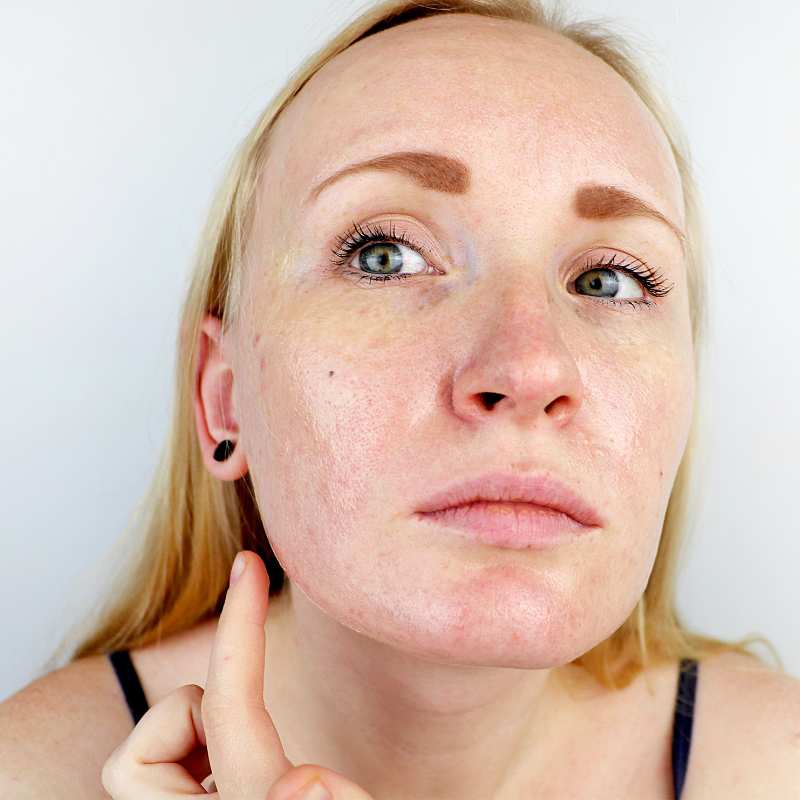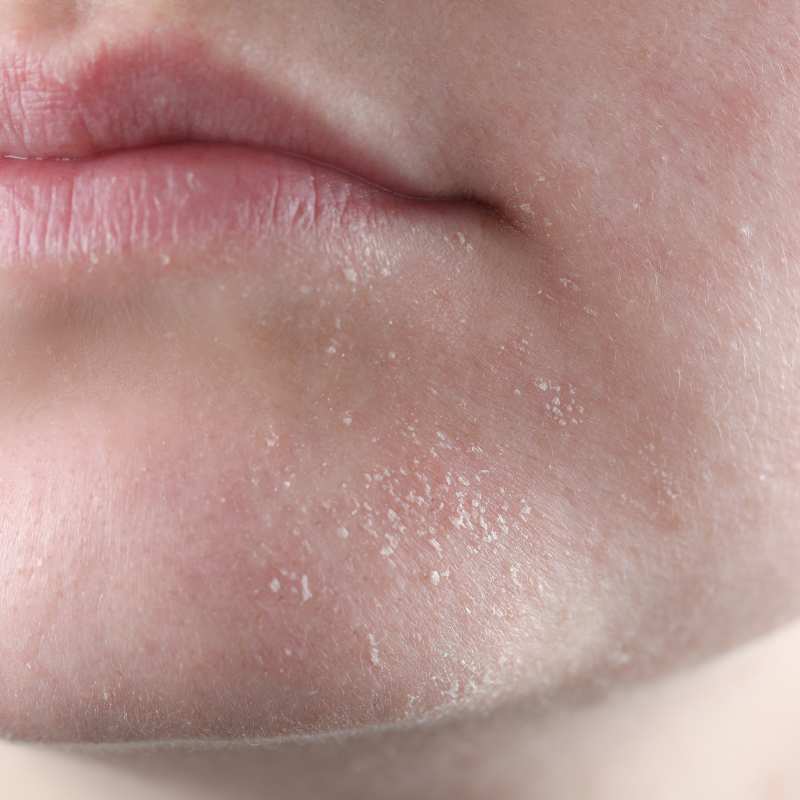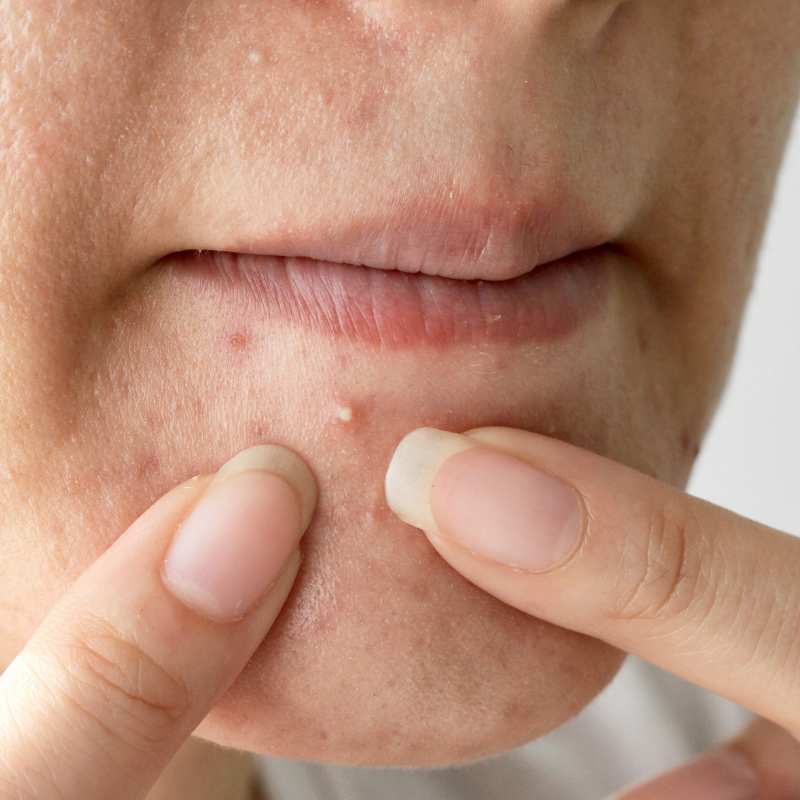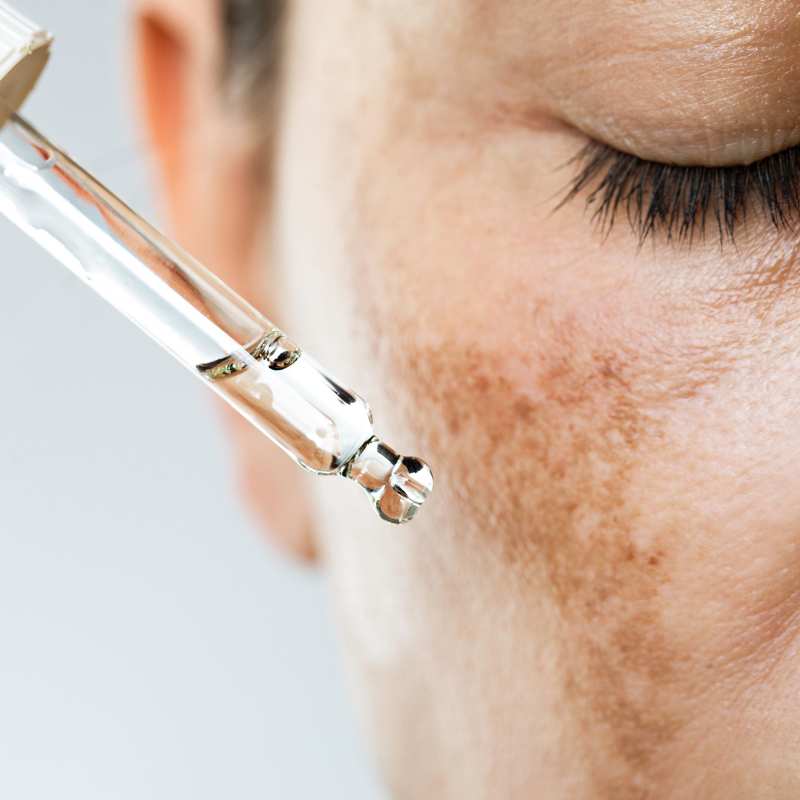Understanding Your Skin Type
Glowing, healthy skin begins with understanding your unique skin type.
Just as each person has their own distinctive fingerprint, every complexion tells a skin story.
Understanding your skin type is vital when it comes to natural skincare because natural ingredients have different properties that interact uniquely with each skin type.
What soothes one skin type may irritate another. An aloe vera gel that hydrates dry skin could overwhelm sensitive skin. An exfoliant with apple cider vinegar that brightens dull complexions may sting acne-prone skin. An astringent that mattifies oily complexions could dehydrate normal skin.
Without insight into your skin’s true nature, choosing suitable natural ingredients becomes guesswork.
Without customisation guided by your skin type, natural ingredients and products can bring risks alongside their benefits (it is a common misperception that natural always equals harmless. But in their raw, unprocessed state, many botanicals retain potent properties that can help or disrupt skin, depending on the type.)
That’s why getting to know your skin type is the critical first step on your natural skincare journey.
Below, I’ll help you understand the different skin types so you can lovingly care for the skin you’re in.
Your Personal Skin Detective Guide
Understanding your unique skin takes some investigating.
Let’s explore the different complexion traits together so you can determine your skin type.
Do you have normal skin?

Normal skin is like a low-maintenance friend that still deserves your attention. Keep things straightforward but regular; your skin will thank you by staying effortlessly radiant.
Characteristics of normal skin
Normal skin is “the chill friend” in the skincare world.
It’s known for its well-balanced oil and moisture levels, giving it a smooth, clear appearance.
This skin type reflects a healthy, hydrated state with fine pores and a generally radiant complexion.
Common misconceptions
Let’s bust a myth: normal skin doesn’t mean ‘no care required.’
It’s easy to think that this balanced skin type can fend for itself but even the most laid-back skin needs love.
Regular cleansing, hydration, and protection are key.
Skipping the basics could invite unwelcome skin changes, so don’t let the “normal” label fool you into complacency.
It’s all about maintaining that beautiful balance.
What keeps normal skin happy?
A consistent, no-fuss skincare routine does the trick.
Use a gentle cleanser to keep it clean without stripping away natural oils.
Hydrate with a lightweight moisturizer – nothing too heavy or too light.
Never skimp on sunscreen – it’s your skin’s best pal for keeping it just right.
Lifestyle counts, too: a balanced diet, adequate hydration, and managing stress keep your skin in its happy zone.
Natural ingredients for normal skin
- Cleansers: Natural oils like coconut, olive, or almond are ideal for normal skin, offering gentle cleansing without disrupting the skin’s natural balance.
- Toners: Rosewater helps maintain the skin’s pH balance, hydrates, and revitalises for a fresh feel.
- Moisturisers: Jojoba oil mimics natural oils and provides balanced hydration for normal skin without leaving a greasy residue.
- Exfoliants: Fruit enzymes from papaya and pineapple exfoliate gently.
- Sun Protection: Zinc oxide mineral sunscreens shield without clogging.
Do you have combination skin?
Combination skin needs some experimenting and personalisation. Observe how each area of your skin responds and adjust your skincare routine to fit. With some testing, you’ll discover the right balance for your unique skin.
Identifying signs
Combination skin is like a unique character in your skincare tale, featuring both oily and dry patches.
You’ll often see an oily T-zone (forehead, nose, and chin) alongside drier cheeks. This mix might also appear along the jawline and hairline.
Look for the signs: a shiny T-zone with larger pores and cheeks that might feel tight or have some dryness.
Managing Combination Skin
Caring for combination skin means treating each part uniquely.
Start with a gentle cleanse to remove oil, but keep moisture in dry areas. Choose cleansers with hydrating ingredients like aloe vera and avoid strong foaming types.
Then, use an alcohol-free toner for the oily T-zone, but skip it on the cheeks to prevent dryness.
For moisturisers, go for a light water-based gel for oily spots and a richer night cream with fatty acids for dry cheeks.
Exfoliate gently, maybe once or twice a week, using scrubs with papaya extract, focusing on the nose and forehead to unclog pores.
For sun protection, choose a zinc oxide or titanium dioxide-based mineral sunscreen for the T-zone. These natural minerals offer effective protection without the harsh chemicals found in some sunscreens.
Combination skin is all about finding the right balance. A tailored routine for each zone can bring your skin into perfect harmony.
Natural ingredients for combination skin
- Cleansers: For the oily T-zone, use gentle cleansers like green tea, which cleanse effectively without over-drying. For the drier areas, consider creamy cleansers with ingredients like chamomile or cucumber that soothe and hydrate.
- Toners: Witch hazel is great for the oily zones, helping to tighten pores and control shine. For the cheeks, a hydrating toner with ingredients like aloe vera or lavender can be more beneficial, providing gentle hydration and soothing properties.
- Moisturisers: Aloe vera gel is perfect for the entire face, offering light hydration without being too heavy for the oily areas. For extra dry spots, consider adding a few drops of argan oil or squalane, which provide deeper hydration without clogging pores.
- Exfoliants: Use mild exfoliants like oatmeal or vegan yogurt. These gently remove dead skin cells and maintain balance, especially effective on the T-zone where combination skin tends to be oilier.
- Sun Protection: Look for sunscreens with natural ingredients like zinc oxide or titanium dioxide for combination skin. These provide effective protection and are less likely to irritate different areas of the skin.
Do you have oily skin?

Oily skin can be a challenge, but with the right approach, you can keep that shine at bay and enjoy a fresh, matte complexion. Remember, it’s about balance, not elimination, of oil.
Key Features
Oily skin is the one that likes to stand out with its glossy sheen.
It’s characterized by excess sebum production, leading to a persistent shine, especially on the forehead, nose, and chin.
This skin type often has visibly larger pores and is prone to various forms of acne, from blackheads to more noticeable breakouts.
The oiliness can vary throughout the day and might be influenced by factors like stress or hormonal changes.
Causes
Why does skin get oily? It’s often a blend of genetics and environmental factors. If oily skin runs in the family, there’s a good chance you might have it too.
Hormonal fluctuations, particularly during adolescence, can kick sebum production into high gear.
External factors like humidity, diet, and overuse of skincare products can also contribute to oiliness.
It’s a complex mix, and understanding these triggers is the first step in managing oily skin effectively.
Daily Management
Controlling oil doesn’t mean stripping your skin bare.
Over-cleansing or using harsh products can backfire, leading your skin to produce even more oil.
Instead, opt for a gentle, oil-free cleanser twice a day.
A light, water-based moisturiser will keep your skin hydrated without adding to the oiliness.
Exfoliate regularly but gently, and embrace blotting papers or mattifying primers for a quick fix during the day.
And let’s not forget sunscreen – look for oil-free formulas that offer protection without clogging pores.
Natural ingredients for oily skin
- Cleansers: Ingredients like tea tree oil and lemon juice are great for oily skin. They help control excess oil and have natural antibacterial properties. Clay-based cleansers can also be effective in absorbing excess oil.
- Toners: Apple cider vinegar is a natural toner for oily skin. It helps balance the skin’s pH and reduces excess oil. Just dilute it with water before applying to avoid irritation.
- Moisturisers: Lightweight, non-comedogenic oils like grapeseed or jojoba oil are ideal. They moisturise without clogging pores or adding extra oiliness.
- Exfoliants: Natural exfoliants like ground oatmeal or coffee grounds can gently remove dead skin cells and control oil. They can be mixed with agave syrup or vegan yoghurt for a soothing, natural scrub.
- Sun Protection: Look for sunscreens with natural ingredients like zinc oxide or titanium dioxide. These minerals provide effective protection without contributing to oiliness or clogging pores.
Do you have dry skin?

Embracing a routine that caters to dry skin’s unique needs can transform it from dehydrated to plush. Remember, gentle care and consistent hydration are the keys to soothing and softening dry skin.
Symptoms
Dry skin is the type that yearns for a drop of moisture. It often feels tight and uncomfortable, especially after cleansing.
You might notice flakiness or a rough, uneven texture, and in some cases, skin may even crack or peel.
This skin type tends to lack the luminous glow and can appear dull.
The dryness isn’t just surface-level; it’s a deeper issue that needs more than just a quick fix.
Underlying Causes
So, what leaves skin dehydrated?
- Often, it’s a natural deficiency in oil production.
- Age can play a role too, as skin tends to get drier with time.
- Environmental factors are also a factor – think cold, windy weather or indoor heating that sucks moisture from the air and your skin.
- Even hot showers and harsh skincare products can strip away natural oils, leaving skin thirstier than ever.
Hydration Tips
Quenching dry skin’s thirst is about layering hydration and locking it in. Start with a gentle, hydrating cleanser that doesn’t strip your skin.
When it comes to moisturisers, richer is better – look for ingredients like lecithin or butters which will hold moisture.
Don’t forget to apply while your skin is still damp to seal in extra hydration. Vegetable oils, in general, can be a dry skin saviour, delivering intense moisture and barrier repair.
And even though your skin is dry, sunscreen is still a must – opt for a hydrating formula.
Lastly, consider a humidifier in your home to keep the air, and your skin, from drying out.
Natural ingredients for dry skin
- Cleansers: Creamy cleansers with natural oils like almond or avocado oil are great for dry skin. They clean gently without stripping away moisture.
- Toners: Rosewater is an excellent toner for dry skin. It’s gentle, hydrating, and helps to balance the skin’s pH. Another option is cucumber water, which is soothing and refreshing.
- Moisturisers: Shea butter and cocoa butter are deeply moisturizing and ideal for dry skin. They provide long-lasting hydration and help to repair the skin barrier.
- Exfoliants: Gentle exfoliants like vegan yoghurt or oatmeal can remove dead skin cells without causing dryness. They also help to soothe and hydrate the skin.
- Sun Protection: Sunscreens with hydrating ingredients like aloe vera or zinc oxide are beneficial for dry skin. They protect from the sun while also moisturizing the skin.
Do you have mature skin?
Caring for mature skin is about improving its present condition, not turning back the clock. The right care can help your skin age gracefully, highlighting the beauty and wisdom that come with age.
Recognising signs of ageing
Mature skin shows life’s journey with lines and wrinkles, like natural marks of experience. They reflect all the emotions you’ve shown over the years.
You may also see changes like thinner, less firm skin and dark spots. These are all part of the unique character of mature skin.
Skin changes
As we get older, our skin changes naturally due to genetics, time, and external factors like sun exposure and lifestyle.
This leads to less collagen and elastin, making skin less firm and elastic.
It also becomes harder for skin to stay moist, leading to dryness.
These changes happen slowly and differ for everyone, but knowing about them is important for taking care of mature skin.
Skin care
Taking care of mature skin means treating it kindly and accepting its changes.
Keeping it hydrated is key, so use rich moisturizers that nourish and protect.
Ingredients like antioxidants are good for stimulating collagen and guarding against environmental harm.
Always use sunscreen, as the sun can speed up ageing signs.
Adding facial massages or gentle exfoliation can improve blood flow and skin renewal.
Caring for mature skin is also about your outlook – it’s a way to celebrate your life’s journey through how you care for your skin.
Natural ingredients for dry skin
- Hydrating Oils: Argan, rosehip, and apricot are excellent for mature skin. They deeply moisturise, help reduce the appearance of fine lines, and improve skin elasticity.
- Antioxidants: Ingredients rich in antioxidants, such as green tea extract, pomegranate, and vitamin E, protect the skin from environmental damage and can help improve its overall texture and tone.
- Moisturisers: Shea butter and cocoa butter are deeply hydrating and can help strengthen the skin’s natural barrier, keeping it soft and supple.
- Collagen-Boosting Agents: Aloe vera and seaweed extracts are known to support collagen production, which is crucial for maintaining the skin’s firmness and elasticity.
- Exfoliants: Natural exfoliants like oatmeal or finely ground almonds can gently remove dead skin cells, promoting a brighter and more even complexion.
- Soothing Agents: Ingredients like chamomile, lavender, and calendula are beneficial for their soothing properties, helping to reduce redness and irritation often associated with mature skin.
Do you have sensitive skin?
Navigating the world of sensitive skin care is about listening to your skin and responding with kindness and gentleness. By understanding its language and triggers, you can create a soothing routine that keeps your skin calm and happy.
Sensitivity Signs
Sensitive skin is like a delicate, reactive type that easily responds to its surroundings. It often shows redness, itching, and irritation.
These reactions can come and go or stay around, feeling like your skin is asking for help.
Sensitive skin might also sting or burn, especially when using certain skincare products or due to environmental factors.
Recognising these signs is important for taking proper care of your skin.
Trigger Identification
Caring for sensitive skin means figuring out what triggers it, like being a detective with your skincare.
Usual irritants are strong chemicals, scents, alcohol in products, and sometimes even natural things like essential oils or some plant extracts.
Things like very hot or cold weather, wind, and sun can also bother sensitive skin.
Watch how your skin responds to new products or different settings to learn what to stay away from.
Soothing Strategies
For sensitive skin, it’s best to keep things simple. Use gentle, fragrance-free products made for sensitive skin.
Choose soothing ingredients like aloe vera, chamomile, and oatmeal.
Moisturize, but with products that don’t irritate. Avoid rough exfoliants – milder chemical ones like lactic acid are better.
Always protect your skin from the sun with sunscreen suitable for sensitive skin.
And sometimes, the best thing is to not use any products at all, especially when your skin is very reactive.
Natural ingredients for sensitive skin
- Soothing agents: Ingredients like aloe vera, chamomile, and calendula are known for their calming and anti-inflammatory properties, making them ideal for sensitive skin.
- Gentle moisturizers: Shea butter, cocoa butter, and oatmeal provide hydration without irritating. They help to soothe and protect the skin barrier.
- Natural oils: Jojoba oil, almond oil, and rosehip oil are gentle and nourishing, helping to moisturise without clogging pores or causing breakouts.
- Antioxidants: Green tea extract and vitamin E are gentle antioxidants that can help protect sensitive skin from environmental stressors while soothing inflammation.
- Hydrators: Although not an oil, hyaluronic acid is a naturally occurring substance in the skin that can help retain moisture and reduce sensitivity.
- Fragrance-Free options: For sensitive skin, it’s often best to choose products free from fragrances, essential oils, or other potential irritants.
Do you have acne-prone skin?

Acne is a common skin issue that can be annoying, but with the right methods and some patience, you can figure out what causes your breakouts and find a skincare routine that suits you.
Acne causes
Acne-prone skin is complex and affected by many things that cause breakouts.
Hormones are a big factor, especially during puberty, pregnancy, or stress, leading to more oil production.
Your lifestyle, like diet, stress, and habits like often touching your face, can also affect acne.
Genetics matter too; if your family has a history of acne, you might get it as well. It’s important to understand these factors to manage acne-prone skin well.
Types of acne
Acne appears in different types, each with unique issues.
Blackheads and whiteheads are the most usual, called non-inflammatory acne.
More inflamed kinds include red and swollen papules and pustules.
Severe acne can be nodules and cysts, which are deeper, hurt more, and can cause scars. Knowing what type of acne you have is key to picking the right treatment.
Prevention and care
Taking care of acne-prone skin means finding the right balance and understanding what works.
Use a gentle cleanser to remove oil and dirt without making your skin too dry.
Exfoliate carefully – too much can make acne worse.
Choose products that don’t block pores. Ingredients like salicylic acid and benzoyl peroxide can help with acne, but use them properly and don’t overuse them.
Keeping your skin hydrated is important, as dry skin can make acne worse.
Also, consider lifestyle aspects like a balanced diet, drinking enough water, and managing stress, as they all play a role in controlling breakouts.
Natural ingredients for acne-prone skin
- Anti-Inflammatory ingredients: Aloe vera, green tea extract, and witch hazel can reduce inflammation and soothe irritated skin, which is crucial for acne-prone skin.
- Natural antimicrobials: Tea tree oil has natural antibacterial properties that can help combat acne-causing bacteria.
- Oil-Regulating ingredients: Jojoba oil and grapeseed oil can help regulate oil production. Despite being oils, they are non-comedogenic and can actually help balance sebum levels in the skin.
- Exfoliants: Gentle natural exfoliants like salicylic acid (found in willow bark) and glycolic acid (found in sugarcane) can help unclog pores and remove dead skin cells, preventing acne formation.
- Clay: Natural clays like bentonite or kaolin clay are excellent for absorbing excess oil and drawing out impurities from the skin, making them great for acne-prone skin.
- Soothing agents: Calendula and chamomile can help calm skin and reduce redness associated with acne breakouts.
Do you have sun-damaged skin?

Dealing with sun-damaged skin involves both repairing past damage and protecting it in the future. By being proactive about sun care and using restorative skincare, you can tackle the effects of previous sun exposure and keep your skin safe for future sunny days.
Damage indicators
Sun-damaged skin shows your history of sun exposure, but not all effects are positive.
Common signs are sunspots or age spots, which are small, dark patches.
Wrinkles and fine lines, often due to collagen damage from UV rays, can be more noticeable. Uneven skin tone and rough texture are also common signs.
These symptoms develop over years of sun exposure, highlighting the need for sun protection.
Protection importance
For sun-damaged skin, preventing damage is much better than trying to fix it later. Always use sunscreen – a broad-spectrum SPF 30 or higher is essential every day, even when it’s cloudy or you’re inside. It’s important to reapply it, especially if you sweat or swim. Also, wear hats, sunglasses, and stay in the shade during the sunniest times. Every step you take to protect your skin helps guard against the sun’s harsh effects.
Repair strategies
If you have sun damage, there are ways to improve it.
Using products with natural active ingredients like bakuchiol can boost collagen production and better skin texture. V
Vitamin C is good for brightening and lessening sunspots. Keeping your skin moisturized aids in repair.
For serious cases or expert advice, seeing a dermatologist can offer specific treatments like laser therapy or chemical peels.
Natural ingredients for sun-damaged skin
- Antioxidants: Ingredients rich in antioxidants, such as green tea extract, vitamin C (found in citrus fruits), and vitamin E, can help combat free radical damage caused by sun exposure and promote skin healing.
- Oils: Rosehip, argan, and coconut oil are excellent for sun-damaged skin. They provide deep hydration, help repair damaged skin cells, and can improve the appearance of sun spots and fine lines.
- Aloe vera: Known for its soothing and healing properties, it is great for calming sunburnt skin and promoting healing.
- Omega fatty acids: Ingredients like flaxseed oil and chia seeds, rich in omega-3 and omega-6 fatty acids, can help repair the skin’s lipid barrier, improving hydration and overall skin health.
- Hydration: Hyaluronic acid, a natural substance in the skin, can help retain moisture and reduce the appearance of sun damage.
- Soothing agents: Calendula and chamomile can soothe and reduce inflammation in sun-damaged skin, helping to alleviate discomfort and redness.
Do you have dull skin?
Adopting a routine that tackles the reasons for dull skin can lead to a brighter, more glowing look. It involves regular care, some patience, and a bit of inner sparkle.
Causes of dullness
Dull skin is like a gem that’s lost its shine, usually due to dead skin cells piling up from not enough exfoliation.
This buildup can make your skin look lifeless.
Being dehydrated also makes skin look dull because dry skin doesn’t reflect light well.
Things like stress, a bad diet, not enough sleep, and pollution can also take away your skin’s natural brightness.
Knowing these causes is the first step to bringing back your skin’s glow.
Reviving radiance
To bring back the brightness in dull skin, focus on enhancing its natural shine from the inside.
Regular, gentle exfoliation is important to get rid of dead skin cells that dull your glow.
Avoid rough scrubs as they can be damaging.
Hydration is also key. Use a good moisturizer, ideally with humectants like hyaluronic acid, to keep moisture in and restore a dewy appearance.
And remember to drink lots of water, as staying hydrated inside is just as crucial.
Brightening techniques
To achieve a brighter complexion, consider safe and natural approaches.
Vitamin C is well-known for its ability to brighten skin and even out skin tone.
Niacinamide is another beneficial ingredient that can enhance texture and luminosity.
Natural options like yogurt masks, honey, or papaya are gentle but effective for boosting skin brightness.
Additionally, eating a balanced diet with plenty of fruits, vegetables, and healthy fats is very important for maintaining healthy skin.
Natural ingredients for dull skin
- Brightening Agents: Ingredients like lemon juice, papaya, and turmeric are known for their natural brightening properties. They can help even out skin tone and add radiance to dull skin.
- Exfoliants: Gentle natural exfoliants like yogurt (which contains lactic acid) and finely ground coffee can remove dead skin cells, promoting a brighter and more even complexion.
- Hydrating Oils: Oils like sweet almond oil and argan oil provide deep hydration and can help restore the skin’s natural glow.
- Antioxidants: Green tea extract and vitamin C (found in citrus fruits) are powerful antioxidants that can rejuvenate dull skin and protect it from environmental stressors.
- Moisturizers: Natural moisturizers like aloe vera and honey not only hydrate but also have soothing and brightening effects on the skin.
- Omega Fatty Acids: Ingredients like flaxseed oil and chia seeds, rich in omega-3 and omega-6 fatty acids, can improve skin health and add to its natural radiance.
Hyperpigmentation

Dealing with hyperpigmentation involves combining prevention, specific treatments, and patience. By using the right methods, you can effectively handle these distinct skin marks, resulting in a more even skin tone. Keep in mind, each spot has its own story, and knowing your skin’s history is crucial for meeting its needs.
Hyperpigmentation explained
Hyperpigmentation is like an unexpected pattern on the skin, showing up as areas darker than the surrounding skin.
It happens when too much melanin, the pigment that gives skin its normal colour, builds up in the skin.
It can appear as age spots, melasma, or post-inflammatory hyperpigmentation.
Usual causes are sun exposure, hormonal changes (like during pregnancy or from birth control), some medications, and inflammation or skin injuries (such as from acne).
Prevention and management
The best way to prevent hyperpigmentation is to protect your skin from the sun.
Using a broad-spectrum sunscreen with at least SPF 30 is crucial, as UV rays can make dark spots worse.
Wearing protective clothing and staying in the shade also helps.
To treat existing hyperpigmentation, products with ingredients like hydroquinone, kojic acid, or glycolic acid can lighten dark spots.
Regularly using these treatments along with sun protection can slowly lessen hyperpigmentation.
Safe lightening options
For a natural approach, there are safe and gentle options.
Ingredients like liquorice extract, vitamin C, and niacinamide are known for lightening skin and are usually less irritating.
Home remedies like aloe vera, turmeric masks, and green tea can also help.
But remember, natural remedies often take longer to show results compared to clinical treatments, so patience is key.
Natural ingredients for hyperpigmentation
- Lightening Agents: Ingredients such as liquorice extract, mulberry extract, kojic acid (derived from fungi), lemon juice, and vitamin C (found in citrus fruits, bell peppers, and berries) are known for their skin-lightening properties. They can help fade hyperpigmentation and even out skin tone.
- Vitamin C: This powerful antioxidant can inhibit melanin production, helping to reduce dark spots and brighten the skin.
- Aloe Vera: Containing aloin, a natural depigmenting compound, aloe vera can lighten skin and reduce the appearance of hyperpigmentation.
- Exfoliants: Gentle natural exfoliants like lemon juice, apple cider vinegar, lactic acid (found in yogurt), and citric acid (found in citrus fruits) can remove dead skin cells and gradually lighten hyperpigmented areas.
- Turmeric: With curcumin, turmeric can reduce melanin production and is effective in treating hyperpigmentation.
- Antioxidants: Green tea extract, vitamin E, and other antioxidants can protect the skin from environmental damage and reduce the appearance of hyperpigmentation.
- Soothing Agents: Aloe vera and rose water can soothe the skin and reduce inflammation often associated with hyperpigmentation.
- Natural Oils: Hydrating oils like rosehip oil and almond oil, rich in vitamins and antioxidants, can improve the appearance of hyperpigmented areas.
Natural oils not only nourish but can also target specific skin concerns. For instance, rosehip oil is celebrated for its high vitamin C content, which aids in brightening and evening out skin tone. Almond oil, rich in vitamin E, provides deep hydration and can help with fading dark spots and scars over time.
These oils work best when incorporated into a consistent skincare routine. A few drops of rosehip oil can be mixed into your night cream or applied directly to the face before bedtime. Almond oil can be used similarly, or even as a gentle makeup remover that doesn’t strip the skin of its natural oils.
Remember, patience is key. Natural remedies work gently and may take time to show visible results. It’s also important to continue protecting your skin from sun exposure, as UV rays can worsen hyperpigmentation.
In addition to topical treatments, a holistic approach to skincare is vital. This includes maintaining a balanced diet rich in antioxidants, staying hydrated, and managing stress levels, as these factors significantly impact skin health.
Finally, it’s essential to note that every skin is unique. What works for one person might not work for another. Therefore, it’s always a good idea to do a patch test when trying new products and consult with a dermatologist, especially for persistent skin issues.
By understanding your skin’s needs and nurturing it with nature’s bounty, you can help reduce the appearance of hyperpigmentation and achieve a more even, radiant complexion.

